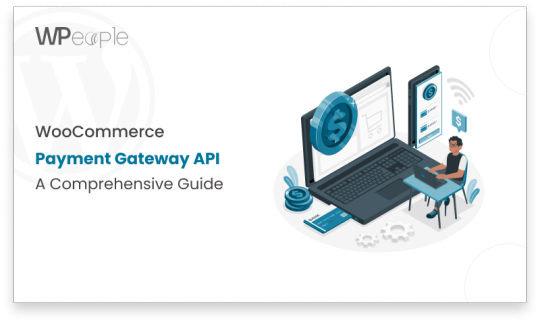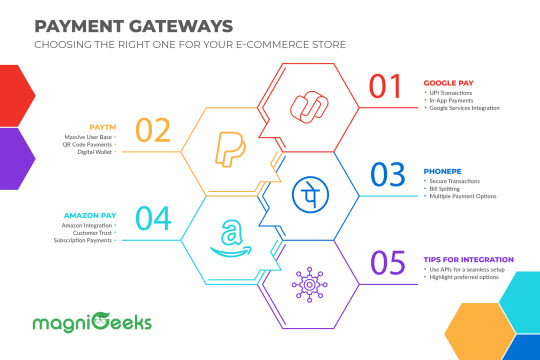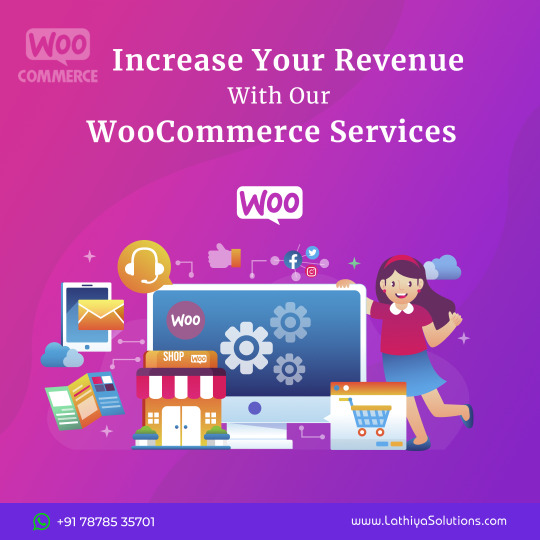#WooCommerce Payments
Explore tagged Tumblr posts
Text
Best Payment Gateways for LearnDash in 2024

In 2024, LearnDash users have a range of payment gateway options to optimize their course delivery. In this blog, we'll explore the 8 top gateways tailored for LearnDash, ensuring a seamless transactional experience alongside quality content. From established players offering robust security to innovative solutions from newcomers, each gateway offers distinct advantages. Whether you prioritize global accessibility, ease of use, or affordability, this guide will assist you in finding the ideal fit for your Custom LearnDash Development platform.
PayPal Pro
Stripe
ApplePay
Authorize.net
Verifone
Mollie Payments for WooCommerce
WooCommerce payments
Square
In 2024, LearnDash users have a wide array of payment gateways to choose from, catering to diverse needs and preferences. Each gateway boasts unique features such as seamless integration, user-friendly interfaces, global transaction support, and advanced security measures. As the e-learning industry expands, selecting the right payment gateway becomes pivotal in ensuring a smooth and secure checkout experience for students. By carefully evaluating your LearnDash site's requirements and target audience, you can pick a payment gateway that not only enhances platform functionality but also contributes to the overall success of your online courses.
Source URL: https://www.saffiretech.com/blog/best-payment-gateways-for-learndash
0 notes
Video
youtube
🚀 WooBooster Partial COD for WooCommerce! 🛒
Are you looking to offer your customers more payment flexibility? With our Partial COD Plugin, you can now allow shoppers to: ✔️ Pay a partial amount at checkout ✔️ Settle the remaining balance on delivery
🔧 Features: ✅ Fixed or percentage-based partial payments ✅ Easy setup and customization ✅ Seamless integration with WooCommerce ✅ Boost trust and conversions on your store!
💡 Give your customers the freedom to shop confidently and improve your sales today!
👉 Download and get started now: https://bit.ly/40CmwmQ
#woocommerce #partialcod #ecommercesolutions #woocommerceplugins #customerexperience
#youtube#wordpress plugin#woocommerce plugin#woobooster partial cod plugin#partial cod payment#partial cash on delivery payment#partial payment#flexibale cod payment in woocommerce#partial cod payment in woocommerce
0 notes
Text
How to Secure Your Membership Site: Best Practices and Plugins
A membership site is a valuable asset for businesses that offer exclusive content or services. However, it also presents a prime target for hackers. To protect your site and your users' data, it's essential to implement robust security measures. Here's a guide on best practices and plugins to secure your membership site.
Best Practices for Membership Site Security
Choose a Strong Password: This is the first line of defense. Use a complex password with a combination of uppercase and lowercase letters, numbers, and symbols. Avoid using easily guessable information like birthdays or pet names.
Regularly Update WordPress and Plugins: Keep your WordPress installation and all plugins up-to-date. Updates often include security patches to address vulnerabilities.
Limit Login Attempts: Restrict the number of unsuccessful login attempts to prevent brute force attacks. This involves configuring your WordPress settings to lock out users after a certain number of failed attempts.
Use Two-Factor Authentication (2FA): This adds an extra layer of security by requiring a second form of verification, such as a code sent to your phone or email. 2FA significantly reduces the risk of unauthorized access.
Protect Against SQL Injection: SQL injection attacks attempt to inject malicious SQL code into a website's database. Use prepared statements or parameterized queries to prevent this type of attack.
Scan for Malware Regularly: Conduct regular malware scans to detect and remove any malicious code that may have compromised your site.
Back Up Your Site: Regular backups are crucial for disaster recovery. In case of a security breach or other unforeseen event, you can restore your site from a previous backup.
Essential Plugins for Membership Site Security
Wordfence Security: This comprehensive security plugin offers firewall protection, malware scanning, real-time threat blocking, and more. It's a popular choice for WordPress sites.
iThemes Security: Another robust security plugin, iThemes Security provides a range of features including strong password enforcement, login security, file scanning, and database security.
WPBruteForceBlocker: This plugin specifically targets brute force attacks by blocking IP addresses after multiple failed login attempts.
Login LockDown: Similar to WPBruteForceBlocker, Login LockDown helps prevent brute force attacks by limiting login attempts and blocking IP addresses.
Sucuri Security: Sucuri offers a cloud-based security platform that provides website firewall protection, malware scanning, DDoS protection, and more.
Additional Tips
Educate Your Users: Encourage your members to practice good security habits, such as using strong passwords and avoiding suspicious links.
Monitor Your Site: Keep an eye on your site's activity for any unusual signs, such as unexpected traffic spikes or error messages.
Stay Informed: Stay updated on the latest security threats and best practices to protect your membership site.
By following these best practices and utilizing the recommended plugins, you can significantly enhance the security of your membership site and protect your users' data.
0 notes
Text
WooCommerce Payment Gateway API: A Comprehensive Guide

Master WooCommerce Payment Gateway API with our comprehensive guide. Learn integration, security, & streamline transactions for your e-commerce store!
0 notes
Text
[solved] Hide WooCommerce COD payment for specific product categories
[solved] Hide WooCommerce COD payment for specific product categories
WooCommerce is a popular ecommerce plugin for WordPress that enables users to sell physical and digital products online. WooCommerce provides various payment gateway options, including Cash on Delivery (COD), that makes it easy to accept payments from customers. But sometimes, merchants may want to hide the COD payment option for particular product categories. For instance, if you are selling…
View On WordPress
0 notes
Text

Choosing the right payment gateway is akin to selecting a trustworthy partner for your e-commerce journey. It should align with your business goals, provide a secure environment, and offer the flexibility needed to cater to your unique customer base. By carefully weighing the factors mentioned above, you can make an informed decision that propels your e-commerce store to new heights of success. The right payment gateway is not just a transaction facilitator; it's a cornerstone of customer trust and satisfaction in the digital realm. To know more visit us at https://shorturl.at/elnCQ
0 notes
Text
#dropshipping#ecommerce#logo design#shopify#payment integration#website#online website#wix#woocommerce#across the spiderverse#etsy#online#succession#welcome home
0 notes
Text
Jetani Brothers UK LTD in London offers the most trusted WooCommerce payment gateways in London to ensure secure and hassle-free transactions for your online business. With our reliable and robust payment solutions, you can protect sensitive customer information and streamline your checkout process. Discover the peace of mind that comes from partnering with Jetani Brothers and enhance your e-commerce experience today.
#WooCommerce Payment Gateways in London#Web Design Company London#Website Development London#Web Design Uk#Web Design And Development Services#Web Development Agency London#Web Development Company London#Web Development London#Wordpress Website Design London#Wordpress Design Agency London#Wordpress Agency In London#Wordpress Website Development London
0 notes
Note
hi — my grandma makes crochet stuff and was looking for an alternative to etsy that is more friendly for handmade crafts specifically. do you have any specific suggestions?
Hello!
Some of our members are working tirelessly to develop the Marketplace Accredidation Program (or MAP), which will function as a thorough and user-friendly database for finding the right marketplace for you -- but in the meantime, we do have a few alternatives I can list that a number of our members would recommend!
There's the Artisans Cooperative, a user/member owned cooperative which is very new and currently member-only, and which has quite a few members in the ISG. It may be worth keeping an eye out for when they open to non-member sellers if your grandma isn't able to become a member by either buying in ($1,000) or spending time earning "member points".
There's GoImagine, which Kristi wrote a blog post about in her Etsy Alterative series. This one donates all of its profits to charity and was the first marketplace to apply for accreditation (once we're ready to begin accreditation) with our MAP. This one isn't member restricted, but it is only available to sellers in the US.
The second marketplace to apply for accredidation is Mayfli, which is based in the UK. I couldn't tell you much else about it, but it does boast its sellers' handmade products.
There's also Ko-Fi, which doubles as a donation platform. We have an earlier blog post about it that goes over and rates it in comparison to Etsy. I myself have used it for tips, sales, and commissions; the fees are low to nonexistent, but you'll have to connect it to PayPal or Stripe to receive payments.
Then there's WooCommerce, which isn't a marketplace, but many of our members use it and have described it as a very good tool for setting up your own website if you're sufficiently tech savvy. This may only be useful for your grandmother if she has outside means of bringing customers to her shop.
We do also have a spreadsheet with the beginnings of an Etsy Alternatives Database, but I'm not sure if that's open to the public just yet. I'll reach out to our other members and add any comments they want to share in a reblog of this post!
#etsy alternatives#kofi#goimagine#woocommerce#artisans cooperative#mayfli#crocheting#asked and answered
42 notes
·
View notes
Text
Open Source eCommerce Platform
An open-source eCommerce platform gives you complete control over your online store. Unlike SaaS-based solutions, these platforms allow deep customization, scalability, and zero transaction fees. Popular choices like Magento, OpenCart, and WooCommerce let you build feature-rich stores with flexible payment gateways and SEO-friendly structures. Open-source eCommerce ensures cost-effective growth, whether you're a startup or an enterprise. Build your brand, own your data, and create a unique shopping experience!
3 notes
·
View notes
Text
Best Payment Gateway In India– Quick Pay

In today's digital era, businesses of all sizes need a reliable, secure, and efficient payment gateway to process online transactions. Whether you're running an e-commerce store, a subscription-based service, or a brick-and-mortar shop expanding to digital payments, choosing the right payment gateway can significantly impact your success. Among the many options available, Quick Pay has emerged as one of the best payment gateways in the industry.
This article explores the features, benefits, security measures, and why Quick Pay is the preferred choice for businesses worldwide.
What is Quick Pay?
Quick Pay is a cutting-edge payment gateway solution that facilitates seamless online transactions between merchants and customers. It offers a secure and user-friendly interface, allowing businesses to accept payments via credit cards, debit cards, mobile wallets, and bank transfers. Quick Pay supports multiple currencies and integrates with various e-commerce platforms, making it a versatile choice for businesses operating locally and globally.
Key Features of Quick Pay
1. Multi-Channel Payment Support
One of the standout features of Quick Pay is its ability to support multiple payment channels, including:
Credit and debit card processing (Visa, Mastercard, American Express, etc.)
Mobile wallets (Apple Pay, Google Pay, PayPal, etc.)
Bank transfers and direct debit
QR code payments
Buy Now, Pay Later (BNPL) services
This flexibility ensures that businesses can cater to customers' diverse payment preferences, thereby enhancing the checkout experience and improving sales conversion rates.
2. Seamless Integration
Quick Pay offers seamless integration with major e-commerce platforms like Shopify, WooCommerce, Magento, and BigCommerce. Additionally, it provides APIs and plugins that allow businesses to customize payment processing according to their specific needs. Developers can easily integrate Quick Pay into their websites and mobile applications without extensive coding knowledge.
3. High-Level Security & Fraud Prevention
Security is a top priority for any payment gateway, and Quick Pay excels in this area with:
PCI DSS compliance (Payment Card Industry Data Security Standard)
Advanced encryption technology to protect sensitive data
AI-driven fraud detection and prevention mechanisms
3D Secure authentication for an extra layer of security
By implementing these security measures, Quick Pay minimizes fraudulent transactions and enhances customer trust.
4. Fast and Reliable Transactions
Speed and reliability are crucial in online payments. Quick Pay ensures that transactions are processed swiftly with minimal downtime. It supports instant payment processing, reducing wait times for merchants and customers alike. Businesses can also benefit from automated settlement features that streamline fund transfers to their bank accounts.
5. Competitive Pricing & Transparent Fees
Unlike many payment gateways that have hidden charges, Quick Pay provides transparent pricing models. It offers:
No setup fees
Low transaction fees with volume-based discounts
No hidden maintenance or withdrawal charges
Custom pricing plans for high-volume merchants
This cost-effective approach makes Quick Pay a preferred choice for startups and large enterprises alike.
6. Recurring Payments & Subscription Billing
For businesses offering subscription-based services, Quick Pay provides a robust recurring payment system. It automates billing cycles, reducing manual efforts while ensuring timely payments. Customers can set up autopay, making it convenient for them and improving customer retention rates for businesses.
7. Multi-Currency & Global Payment Support
In an increasingly globalized economy, accepting international payments is vital. Quick Pay supports transactions in multiple currencies and offers dynamic currency conversion. This allows businesses to cater to international customers without dealing with complex exchange rate issues.
Benefits of Using Quick Pay
1. Enhanced Customer Experience
Quick Pay ensures a smooth checkout experience by providing multiple payment options and a user-friendly interface. Faster payment processing reduces cart abandonment and boosts customer satisfaction.
2. Improved Business Efficiency
With automated invoicing, seamless integration, and real-time transaction tracking, businesses can streamline their payment operations, saving time and resources.
3. Higher Security & Reduced Fraud Risk
With its state-of-the-art security measures, Quick Pay minimizes risks associated with fraud and data breaches. This enhances business credibility and customer trust.
4. Increased Sales & Revenue
Supporting multiple payment options and international transactions helps businesses tap into a broader customer base, leading to higher sales and revenue growth.
How to Set Up Quick Pay for Your Business?
Setting up Quick Pay is a straightforward process:
Sign Up – Visit the Quick Pay website and create an account.
Verify Business Details – Submit the required business documents for verification.
Integrate Quick Pay – Use APIs, plugins, or custom scripts to integrate Quick Pay into your website or app.
Configure Payment Options – Select the preferred payment methods you want to offer customers.
Go Live – Once approved, start accepting payments seamlessly.
Why Quick Pay Stands Out Among Competitors
While several payment gateways exist, Quick Pay differentiates itself with:
Superior security measures compared to standard gateways.
Faster payouts than many competitors, ensuring businesses receive funds quicker.
Customer-friendly interface making it easier for both merchants and users.
Scalability, accommodating businesses from small startups to large enterprises.
Conclusion
Quick Pay is undoubtedly one of the best payment gateway in India available today. Its blend of security, efficiency, affordability, and ease of use makes it an ideal choice for businesses across various industries. Whether you run an e-commerce store, a SaaS business, or a global enterprise, Quick Pay ensures smooth, secure, and hassle-free payment processing.
By choosing Quick Pay, businesses can enhance customer experience, reduce fraud risks, and boost revenue. With seamless integration, multi-currency support, and advanced features, Quick Pay is the go-to payment gateway for modern businesses looking for a reliable and future-proof payment solution.
Are you ready to streamline your payments and take your business to the next level? Sign up for Quick Pay today!
2 notes
·
View notes
Text
QR Code Payment for WooCommerce with USSD Mobile Banking Payment
#airtelmoney#alipay#GCASH#grabpay#kakaopay#mobikwik#mpesa#mtnmobilemoney#orangemoney#paytm#Phonepe#swish#truemoney#venmo#wechatpay
2 notes
·
View notes
Text
Top WordPress Plugins to Supercharge Your Website in 2024

Building and maintaining a WordPress site is both exciting and challenging. While the platform provides a robust foundation, the true power of WordPress lies in its plugins. From enhancing site functionality to improving user experience, WordPress plugins are indispensable tools for developers, businesses, and bloggers alike. In this blog, we’ll explore the best WordPress plugins that can transform your website into a highly functional, user-friendly, and SEO-optimized powerhouse.
What Are WordPress Plugins?
WordPress plugins are software add-ons designed to extend the functionality of your WordPress site. Whether you need to improve site speed, enhance SEO, secure your website, or add unique design features, there’s likely a plugin for that. Plugins allow both beginners and advanced users to customize their sites without coding expertise.
With over 60,000 plugins available on the WordPress Plugin Directory alone, the options can feel overwhelming. Choosing the right plugins for your website’s goals is critical for success. Below, we’ve rounded up some of the most essential WordPress plugins to consider.
Must-Have WordPress Plugins for Every Website
1. Yoast SEO
SEO is crucial for driving organic traffic to your site, and Yoast SEO is one of the best tools for optimizing your content. This plugin provides on-page optimization tips, readability analysis, and technical SEO tools to help your site rank higher on search engines.
2. Elementor
Looking to build a visually stunning website without hiring a designer? Elementor is a drag-and-drop page builder that makes designing websites easy. Its intuitive interface and vast array of widgets allow you to create professional-looking pages in minutes.
3. WPForms
For websites that rely on user interaction, a contact form is a must-have feature. WPForms allows you to create customizable, mobile-responsive forms effortlessly. Whether it’s contact forms, surveys, or payment forms, this plugin has you covered.
4. WooCommerce
If you’re running an online store, WooCommerce is the go-to plugin. It transforms your WordPress site into a fully functional e-commerce platform, complete with features for product listings, payment gateways, and inventory management.
5. Akismet Anti-Spam
Spam comments can clutter your website and ruin user experience. Akismet Anti-Spam automatically filters out spam comments, keeping your site clean and professional.
6. Jetpack
Created by Automattic, the team behind WordPress, Jetpack is a multipurpose plugin offering features like performance optimization, security, site analytics, and social media integration.
7. Rank Math
Another excellent SEO plugin, Rank Math provides advanced features like schema integration, keyword tracking, and detailed analytics. It’s an excellent alternative to Yoast SEO for more advanced users.
8. UpdraftPlus
Backup and restoration are critical for any website. UpdraftPlus allows you to schedule automatic backups and store them securely on cloud services like Google Drive or Dropbox.
9. Smush
Site speed plays a major role in user experience and search engine rankings. Smush compresses images without compromising quality, helping your site load faster.
10. MonsterInsights
Understanding how visitors interact with your site is essential. MonsterInsights integrates Google Analytics directly into your WordPress dashboard, offering real-time insights into traffic, user behavior, and more.
11. W3 Total Cache
Slow-loading websites lose visitors and revenue. W3 Total Cache improves website performance by caching static files and optimizing server resources.
12. Sucuri Security
Cybersecurity is non-negotiable in today’s digital landscape. Sucuri Security offers malware scanning, firewall protection, and blacklist monitoring to keep your site secure.
13. Social Snap
Boost social media engagement with Social Snap, a powerful social sharing plugin. It offers customizable sharing buttons and in-depth analytics to track your social media performance.
14. Litespeed Cache
For websites hosted on LiteSpeed servers, LiteSpeed Cache is a high-performance optimization plugin that enhances speed and reduces server load.
15. TablePress
If your site needs to display complex data, TablePress is a lifesaver. It lets you create and manage tables without requiring any coding knowledge.
Why Use WordPress Plugins?
Enhanced Functionality: WordPress plugins extend the capabilities of your site, making it easier to achieve your goals.
Ease of Use: Many plugins are beginner-friendly and require no technical expertise.
Scalability: Whether you’re running a blog, an e-commerce store, or a portfolio, plugins grow with your needs.
Cost-Effective: Most plugins offer free versions with premium features, making them accessible for all budgets.
Tips for Choosing the Right WordPress Plugins
Identify Your Needs: Start by determining what features your site requires.
Check Reviews and Ratings: Plugins with high ratings and positive reviews are generally more reliable.
Update Frequency: Look for plugins that are updated regularly to ensure compatibility with the latest WordPress version.
Avoid Overloading: Too many plugins can slow down your site. Stick to essential ones.
Final Thoughts
WordPress plugins are the backbone of a successful website. By selecting the right ones, you can enhance your site’s functionality, user experience, and performance. Whether you’re aiming to boost your SEO, secure your site, or create stunning designs, there’s a plugin tailored for your needs.
Experiment with the plugins mentioned above and watch your WordPress site thrive. Remember to regularly review your plugin list and update them to ensure optimal performance.
4 notes
·
View notes
Text

Step-by-Step Guide to Selling Digital Products with Ease
The digital economy is booming, and selling digital products—like eBooks, courses, templates, or printables—has never been more accessible. With low startup costs and limitless scalability, it’s an ideal venture for creators and entrepreneurs. Here’s how to start your journey effortlessly:
1. Identify Your Niche & Audience
Begin by pinpointing a niche you’re passionate about and that has demand. Research communities on social media, forums, or platforms like Reddit to understand pain points. For example, if you’re skilled at graphic design, consider offering Canva templates for small businesses. Narrowing your focus helps you stand out.
2. Validate Your Idea
Before investing time, validate demand. Use surveys, polls, or pre-sale offers to gauge interest. Share a concept on Instagram or LinkedIn and ask followers if they’d buy it. Tools like Google Forms or Gumroad’s pre-order feature can simplify this step.
3. Create Your Product
Focus on quality and usability. Use tools like Canva for design, Teachable for courses, or Adobe Audition for audio guides. Keep it simple—start with one product (e.g., a PDF workbook) before expanding. Ensure it’s professionally presented and solves a specific problem.
4. Choose a User-Friendly Platform
Select a platform that handles hosting and sales. Options like Gumroad, Ko-fi, or Etsy are beginner-friendly. For more control, use Shopify or WordPress with WooCommerce. Prioritize platforms with built-in marketing tools and analytics.
5. Set Up Payments & Pricing
Integrate secure payment gateways like Stripe or PayPal. Price your product strategically: research competitors, consider value-based pricing (e.g., $29 for a time-saving template bundle), or offer tiered options (basic vs. premium).
6. Launch & Market Smartly
Build anticipation before launching. Share snippets on social media, collaborate with micro-influencers, or offer limited-time discounts. Use email lists (start with free lead magnets) and SEO-friendly product descriptions to drive organic traffic.
7. Prioritize Customer Support
Automate delivery using platforms like SendOwl to avoid manual work. Create a FAQ section and respond promptly to queries. Positive reviews boost credibility, so encourage feedback with follow-up emails.
8. Analyze & Scale
Track sales and customer behavior with analytics tools. Identify top-performing marketing channels and double down. Expand your offerings based on demand—turn a popular eBook into a video course, or bundle products for upsells.
Final Thoughts
Selling digital products is a rewarding way to monetize your skills. By starting small, validating ideas, and leveraging the right tools, you can build a sustainable online business with minimal friction. Ready to launch? Your audience is waiting!
Take the first step today—create, share, and grow. The digital world is yours to conquer.
(Word count: 500)
This guide balances actionable steps with encouragement, ensuring readers feel empowered to start their digital product journey without overwhelm. Each section is concise, with practical examples to inspire immediate action.
#explore#digital marketing#digital product#selling#Sell digital products#Digital product creation#Online business ideas#Passive income strategies#Niche research#Audience validation#Low startup costs#Digital product platforms (e.g.#Gumroad#Etsy#Shopify)#Value-based pricing#Email list building#Social media marketing#SEO-friendly content#Customer support automation
2 notes
·
View notes
Text

🚀 Increase Your Sales with Our WooCommerce Services & Support! 🛒 Struggling to boost your sales? Lathiya Solutions is here to help! With our expert WooCommerce expertise, we ensure your eCommerce store is fast, secure, and optimized for conversions. ✅ Custom WooCommerce Store Design & Development ✅ Speed Optimization for Faster Checkout ✅ Bug Fixing & Troubleshooting ✅ Payment Gateway & Shipping Integration ✅ Security Enhancements & Malware Protection ✅ 24x7 Support & Maintenance 🎯 With 15+ years of experience, we create high-performing WooCommerce stores that turn visitors into loyal customers! 📞 Boost Your Sales Today! 📲 WhatsApp: +91 7878 5357 01 🌍 Visit: https://lnkd.in/fFRPrFg ✨ Let’s build a store that sells more, every day! 💰 #WooCommerceExpert #IncreaseSales #eCommerceSuccess #LathiyaSolutions #WordPressWooCommerce
2 notes
·
View notes
Text
10 Steps to Launch Your Dream Business Online Successfully

In today’s digital era, businesses thrive online as more consumers prefer shopping and engaging with brands virtually. To succeed in this competitive space, you must establish a strong online presence and build a brand that stands out. If you’re ready to start your dream business online, this guide will walk you through the essential 10 steps to launch successfully.
Step 1: Define Your Business Idea
Start by clearly defining your business concept. Identify your target audience, the products or services you will offer, and what makes your brand unique. Your unique value proposition (UVP) should set your business apart and address a specific customer need or pain point.
Step 2: Conduct Market Research
Research your industry, competitors, and customer preferences. Understanding market demand will help you tailor your offerings. Analyze competitors’ strengths and weaknesses to identify gaps in the market that your business can fill. Engage with similar businesses to gain insights and advice.
Step 3: Create a Business Plan
A well-structured business plan outlines your goals, marketing strategies, financial projections, and operational structure. This roadmap guides you through launching and scaling your business. If you seek funding, investors will require a solid business plan detailing startup costs, revenue forecasts, and growth strategies.
Step 4: Choose a Memorable Domain Name
Your domain name should align with your brand, be easy to remember, and represent your business niche. Ensure it is available and register it with a trusted domain provider. A strong domain reinforces brand identity and improves searchability.
Step 5: Build a Professional Website
A user-friendly, visually appealing website is essential for credibility. Platforms like WordPress, Shopify, or Squarespace offer easy-to-use website builders. If budget allows, consider hiring a web designer to create a custom site that reflects your brand’s professionalism.
Step 6: Develop a Strong Online Presence
Implement SEO strategies, content marketing, and social media engagement to grow your visibility. Utilize platforms like Instagram, LinkedIn, and Facebook to connect with potential customers. Create valuable content to attract and retain visitors.
Step 7: Set Up E-Commerce Capabilities
If selling products or services, integrate a secure e-commerce platform. Ensure a smooth checkout experience, reliable payment gateways, and efficient order processing. Platforms like Shopify, WooCommerce, or BigCommerce offer robust e-commerce features.
Step 8: Establish a Brand Identity
Your brand identity includes a logo, color scheme, and consistent design elements across all platforms. A cohesive brand image builds trust and recognition. Apply branding across your website, marketing materials, and social media.
Step 9: Build a Customer Base
Engage with potential customers through email marketing, loyalty programs, and referral incentives. Provide exceptional customer service to build long-term relationships. Word-of-mouth marketing can be a powerful tool in expanding your audience.
Step 10: Monitor, Evaluate, and Adapt
Use analytics tools to track performance. Regularly review customer feedback, sales trends, and engagement metrics to make data-driven improvements. Adapt your strategies to enhance customer experience and business growth.
By following these steps, you can successfully launch and grow a thriving online business that stands out in the digital marketplace.
2 notes
·
View notes